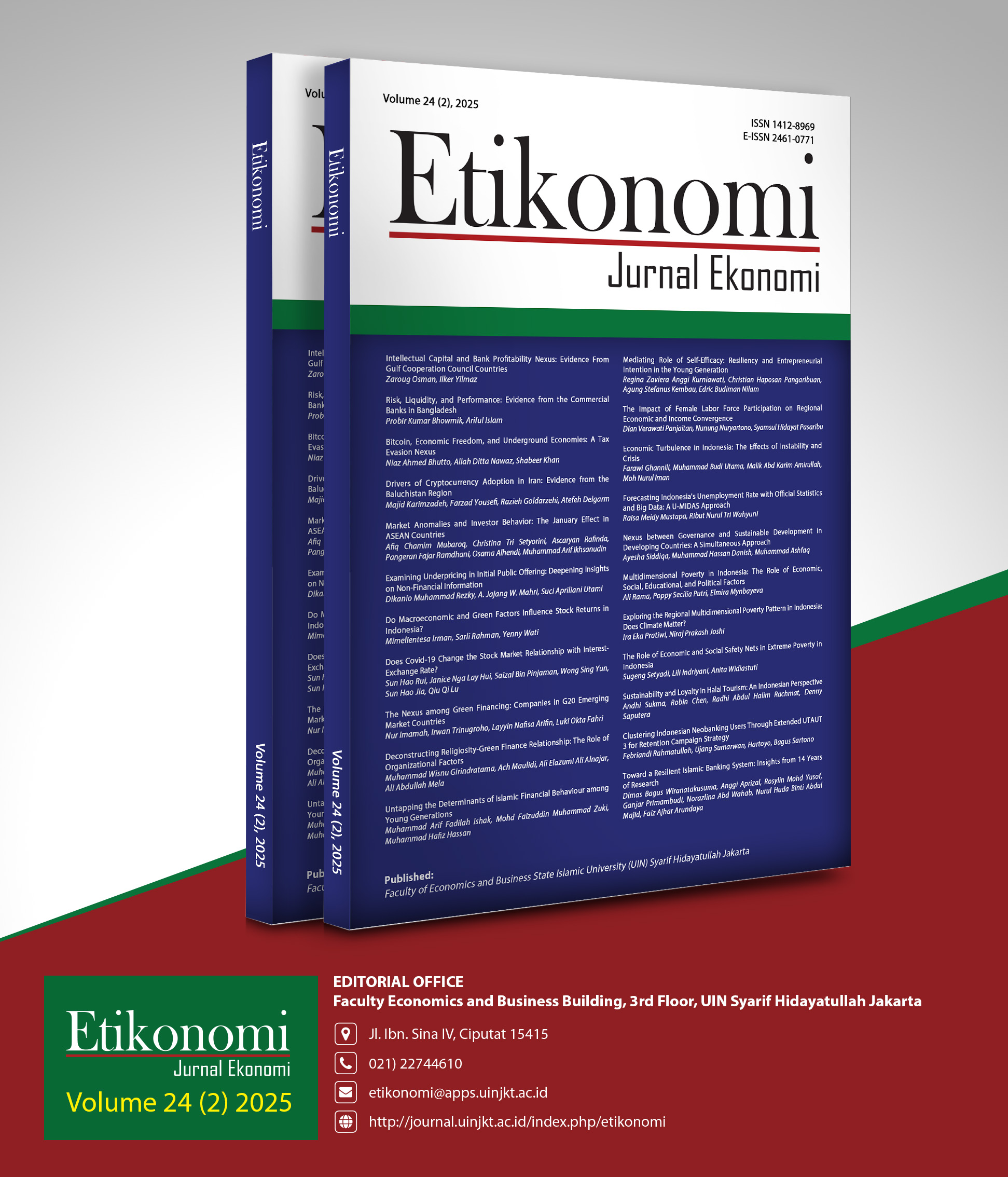Clustering Indonesian Neobanking Users Through Extended UTAUT 3 for Retention Campaign Strategy
DOI:
https://doi.org/10.15408/etk.v24i2.42599Abstract
Research Originality: This study develops a behavior-anchored segmentation framework for Indonesian neobank users by extending the Unified Theory of Acceptance and Use of Technology (UTAUT-3) with trust and marketplace application usage, providing deeper insights into user behavior.
Research Objectives: The research aims to identify distinct neobank user segments and key behavioral drivers to support targeted strategies in digital financial services.
Research Method: An extended UTAUT-3 model incorporating trust and marketplace usage was validated through Structural Equation Modeling (SEM). Balanced Iterative Reducing and Clustering using Hierarchies (BIRCH) clustering was applied to data from 386 active users, with segment validity confirmed using Elbow, Gap, and Silhouette methods.
Empirical Results: The results revealed that trust, habit, and marketplace usage emerged as primary drivers of engagement and user recommendations. This study identifies four user segments: transitioning explorers, urban occasionalists, rural digital enthusiasts, and cost-conscious digital natives.
Implications: Urban Occasionalists and Rural Digital Enthusiasts show strong potential for long-term growth. Targeted engagement and personalized retention strategies for these segments can enhance customer lifetime value and strengthen user advocacy.
JEL Classification: G21, M31, C38
Downloads
References
Alalwan, A. A. (2020). Mobile Food Ordering Apps: An Empirical Study of the Factors Affecting Customer E-Satisfaction and Continued Intention to Reuse. International Journal of Information Management, 50(1), 28–44.
Bhatnagr, P., & Rajesh, A. (2024). Neobanking Adoption – An Integrated UTAUT-3, Perceived Risk And Recommendation Model. South Asian Journal of Marketing, 5(2), 93-112. https://doi.org/10.1108/SAJM-06-2022-0040.
Chong, A. Y. L., Lacka, E., Boying, L., & Chan, H. K. (2018). The Role of Social Media in Enhancing Guanxi and Perceived Effectiveness of E-Commerce Institutional Mechanisms in Online Marketplace. Information & Management, 55(5), 621–632.
Farooq, M. S., Salam, M., Jaafar, N., Fayolle, A., Ayupp, K., Radovic-Markovic, M., & Sajid, A. (2017). Acceptance and Use of Lecture Capture System (LCS) in Executive Business Studies: Extending UTAUT2. Interactive Technology and Smart Education, 14(4), 329–348.
Gunasinghe, A., Hamid, J. A., Khatibi, A., & Azam, S. M. F. (2020). The Adequacy of UTAUT-3 in Interpreting Academician’s Adoption to E-Learning in Higher Education Environments. Interactive Technology and Smart Education, 17(1), 86–106.
Hair, J. F., Ringle, C. M., & Sarstedt, M. (2013). Partial Least Squares Structural Equation Modeling: Rigorous Applications, Better Results and Higher Acceptance. Long Range Planning, 46(1–2), 1–12. https://doi.org/10.1016/j.lrp.2013.01.001.
Hopkinson, G. G., & Klarova, D. (2019). How Neobanks’ Business Models Challenge Traditional Banks. Working Paper of International Business Centre at Aalborg University.
John, J. M., Shobayo, O., & Ogunleye, B. (2023). An Exploration of Clustering Algorithms for Customer Segmentation in the UK Retail Market. Analytics, 2, 809–823.
Kim, G., & Koo, H. (2016). The Causal Relationship Between Risk and Trust in the Online Marketplace: A Bidirectional Perspective. Computers in Human Behavior, 55, 1020–1029.
Pinto, A. S., Abreu, A., Costa, E., & Paiva, J. (2022). Augmented Reality for a New Reality: Using UTAUT-3 to Assess the Adoption of Mobile Augmented Reality in Tourism (MART). Journal of Information Systems Engineering and Management, 7, 14550.
Pradana, M. G., & Ha, H. T. (2021). Maximizing Strategy Improvement in Mall Customer Segmentation using K-means Clustering. Journal of Applied Data Sciences, 2(1), 19–25.
Rahi, S., Othman Mansour, M. M., Alghizzawi, M., & Alnaser, F. M. (2019). Integration of UTAUT Model in Internet Banking Adoption Context: The Mediating Role of Performance Expectancy and Effort Expectancy. Journal of Research in Interactive Marketing, 411–435. https://doi.org/10.1108/JRIM-02-2018-0032.
Rouibah, K., Lowry, P. B., & Hwang, Y. (2016). The Effects of Perceived Enjoyment and Perceived Risks on Trust Formation and Intentions to Use Online Payment Systems: New Perspectives From an Arab Country. Electronic Commerce Research and Applications, 19, 33–43. https://doi.org/10.1016/j.elerap.2016.07.001.
Sari, D., Rafiah, K. K., Muizu, W. O. Z., & Alamanda, A. R. (2023). Antecedents of the Digitization of Small and Medium Enterprises: Case in Sumedang Indonesia. Kontigensi : Jurnal Ilmiah Manajemen, 11(1), 102–114. https://doi.org/10.56457/jimk.v11i1.351.
Venkatesh, V., Morris, M. G., Davis, G. B., & Davis, F. D. (2003). User Acceptance of Information: Towar a Unified View. MIS Quarterly, 27(3), 425–478.
Venkatesh, V., Thong, J. Y. L., & Xu, X. (2012). Consumer Acceptance and Use of Information Technology: Extending The Unified Theory of Acceptance and Use of Technology. MIS Quarterly, 36(1), 157–178.
Wang, A. L., Zhong, X., & Hurd, Y. L. (2020). Comorbidity and Sociodemographic Determinants in COVID-19 Mortality in an US Urban Healthcare System. MedRxiv.
Zhang, T., Ramakrishnan, R., & Livny, M. (1997). BIRCH: A New Data Clustering Algorithm and Its Applications. Data Mining and Knowledge Discovery, 1, 141–182.
Downloads
Published
Issue
Section
License
Copyright (c) 2025 Febriandi Rahmatulloh, Ujang Sumarwan, Hartoyo Hartoyo, Bagus Sartono

This work is licensed under a Creative Commons Attribution-ShareAlike 4.0 International License.










